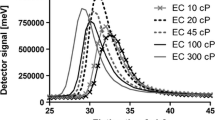Abstract
A method has been elaborated for the dilatometric investigation of compressed samples of acetylcellulose (AC) with the aid of the derivatograph. The determined glazing temperature shows a good coincidence with the literatureT g data for fibres and films. This allows the conclusion that orientation processes do not affect the transition. The development of crystallization has been established predominantly in heterogeneous highly esterified AC (60% CH3COOH).
Résumé
On a mis au point une méthode pour l'étude dilatométrique d'échantillons comprimés d'acétylcellulose à l'aide d'un “Derivatograph”. La température trouvée pour la vitrification est en bon accord avec les données de la littérature pour les fibres et les films. Ceci permet de conclure que les processus d'orientation n'influencent pas la transition. On a établi que le développement de la cristallisation s'effectuait en majorité dans l'acétylcellulose hétérogène fortement estérifiée (60% CH3COOH).
Zusammenfassung
Es wurde eine Methode zur dilatometrischen Untersuchung von Acetylcellulose-Preßlingen mit Hilfe des Derivatographen ausgearbeitet. Die bestimmte Verglasungstemperatur ist in guter Übereinstimmung mit den der Literatur entnommenen ähnlichen Temperaturen bei Fasern und Filmen. Die Orientierungsvorgänge üben folglich keinen Einfluß auf den Übergang aus. Man stellte fest, daß die Kristallisation hauptsächlich in heterogener, hochveresterter Acetylcellulose erfolgt (60% CH3COOH).
Резюме
Разработан метод дил атометрического изучения прессованн ых образцов ацетилцеллюлозы (АЦ) с помощью дериватогра фа. Определяемая темпер атура стеклования хорошо совпадает с ли тературными данными. Это позволяет сделать вы вод, что ориентационные проц ессы не оказывают на п ереход никакого влияния. Уст ановлено, что развитие кристал лизации преобладает в гетерогенной, высоко этерифицированной А Ц (60% CH3COOH).
Similar content being viewed by others
References
R. F. Boyer, Polym. Sci. C., 14 (1966) 3.
K. Dimov, V. Sarmadjieva, Khimia i Industria, 6 (1966) 407; 10 (1966) 403.
L. Erdey, F. Paulik, J. Paulik, Acta Chim. Acad. Sci. Hung., 10 (1965) 61.
V. B.Rijhov, N. F.Bakeev, T. B.Koratkova, P. V.Kozlov, VMC., Edit. sb. “Tzeluloza i eyo proizvodnie” AN USSR, Moscow, 1963, p. 139.
V. G.Timofeeva, G. D.Zaitzeva, G. M.Bartenev, P. V.Kozlov, VMC., Edit. sb. “Tzeluloza i eyo proizvodnie” AN USSR, Moscow, 1963, p. 181.
P. V.Kozlov, I. F.Kaimin, Z. Z.Geleis, A. M.Kurbanov, V. A.Kargin, VMC, A. IX. 9 (1967) 2047.
P. V.Kozlov, I. F.Kaimin, V. A.Kargin, DAN, USSR, 167, 6 (1966) 132.
G. M. Bartenev, Yu. V. Zelenev, Mech. Polymerov, 1 (1969) 30.
Author information
Authors and Affiliations
Rights and permissions
About this article
Cite this article
Dimov, K., Betchev, C. & Sarmadjieva, V. An investigation on the transition temperatures of acetylcellulose. Journal of Thermal Analysis 5, 397–406 (1973). https://doi.org/10.1007/BF01950230
Received:
Revised:
Issue Date:
DOI: https://doi.org/10.1007/BF01950230



